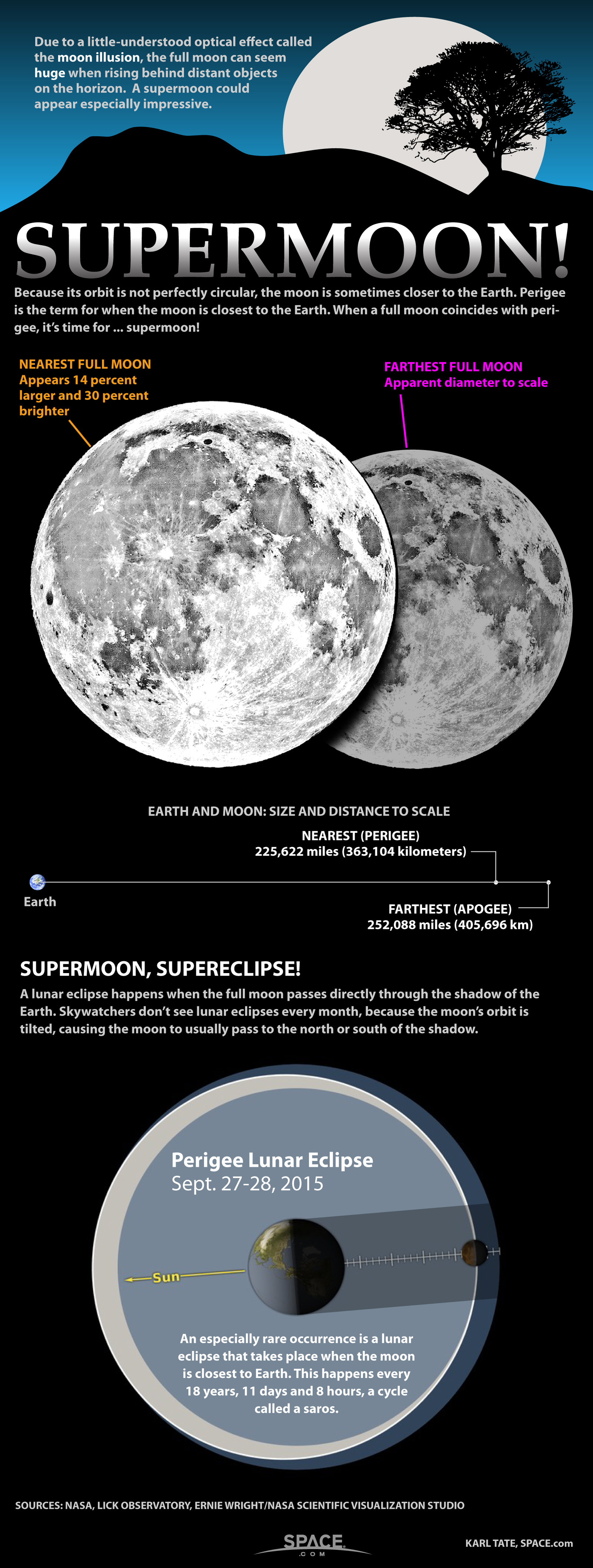When the "Full Cold Moon" rises on Sunday night (Dec. 3). It will also be the first (and last) "supermoon" of 2017.
Supermoons happen when a full moon approximately coincides with the moon's perigee or a point in its orbit at which it is closest to Earth. This makes the moon appear up to 14 percent larger and 30 percent brighter than usual.
The moon becomes totally full at 10:47 a.m. EST (1547 GMT) on Sunday (Dec. 3). It will officially reach perigee the next day (Dec. 4) at 3:45 a.m. EST (0845 GMT), when it is 222,135 miles (357,492 kilometers) away from Earth.
What is a supermoon?
While the moon's average distance is 238,000 miles (382,900 km) from Earth, its orbit isn't perfectly circular, so that distance varies a small amount. When it reaches apogee, or its farthest distance from Earth, on Dec. 19, it will be 252,651 miles (406,603 km) away. That's a difference of 30,516 miles (48,110 km) — but the moon's distance from Earth can vary more than that.
The perigee for December's supermoon won't even be the closest this year; that happened May 25, when the not-so-super new moon was 221,958 miles (357,208 km) away from Earth. That date didn't coincide with a full moon, though, so it didn't qualify as a supermoon.


Supermoons can appear 30 percent brighter and up to 14 percent larger than typical full moons. Learn what makes a big full moon a true 'supermoon' in this Space.com infographic.
Credit: Karl Tate/SPACE.com
Supermoons don't happen every month because the moon's orbit changes orientation as the Earth goes around the sun. So, the long axis of the moon's elliptical path around the Earth points in different directions, meaning that a full (or new) moon won't always happen at apogee or perigee.
When to see the supermoon
In New York City, the full moon will rise the evening of Dec 3. at 4:59 p.m. local time. Moonset will be the morning of Dec. 4 at 7:50 a.m., according to timeanddate.com. The sun sets at 4:28 p.m. on Dec. 3, so the full moon and the sun will not be visible at the same time, at least in New York.
If you want to see both in the sky at once, you need to go below the equator. In Wellington, New Zealand, the full moon happens at 4:46 a.m. local time on the morning of Dec. 4, and sets at 6:10 a.m., half an hour after the sun rises at 5:41 a.m.
Look for the full moon in the constellation of Taurus. Though the moon is officially full on Dec. 3, it will still appear full to the casual observer the night before and after.
A lunar occultation
As it did in November, the full moon will pass in front of, or "occult," the bright star Aldebaran. This event will be visible from northern Canada, Alaska, eastern Russia, Kazakhstan, much of China and as far south as Bangladesh.
In the continental U.S., residents of Washington state can catch the occultation; People in Seattle will see the predawn moon pass in front of Aldebaran at 6:09 a.m. local time, reappearing at 6:46 a.m. In Boise, Idaho, the occultation will start at 7:15 a.m., but skywatchers there won't get to see Aldebaran reappear from behind the moon, as the occultation ends after the moon sets at 7:43 a.m.
In Anchorage, Alaska, Aldebaran disappears behind the moon at 4:38 a.m. local time and reappears at 5:32 a.m. The moon becomes full soon after that at 6:46 a.m. local time, setting at 9:20 a.m. Canadian observers in Vancouver will see the occultation start at 6:06 a.m. and end at 6:46 a.m. (Full moon is at 7:46 a.m.)
Observers in Asia will see more of the occultation. In Beijing, the event starts at 7:54 p.m. local time and ends at 8:37 p.m. — better timed for those who'd rather not get up too early.
How the Full Cold Moon got its names
According to the Old Farmer's Almanac, the name of the full moon in December is "Full Cold Moon," and given the weather in December (at least in the Northern Hemisphere), that's not a surprise.
This is also reflected in the names from native peoples of North America. According to the Ontario Native Literacy Project, the Ojibwe called December's full moon "Mnidoons Giizis," the "Big Spirit Moon" or "Blue Moon." For the Ojibwe, it marked the 12th calendar month and was a time for healing. The Haida of the Pacific Northwest called it the "Snow Moon," or "Ta'aaw Kungaay."
Among the Hopi, whose ceremonial life revolved around the lunar and solar cycles, the lunation just before the winter solstice was the "Sparrow-Hawk" moon, as noted by Janet Sharp of Washburn University in her study of Hopi mathematical concepts and teaching.
In the Southern Hemisphere, December is summertime. The Māori of New Zealand described the lunar months in November to December as Hakihea, or "birds are now sitting in their nests," according to the Encyclopedia of New Zealand.
In China, the traditional lunar calendar calls the December lunation the 10th month. Called Yángyuè, or Yang month, it's named for the yang ― the masculine, positive principle of Taoism familiar to Westerners as part of the yin and yang.
like and Share...
like and Share...